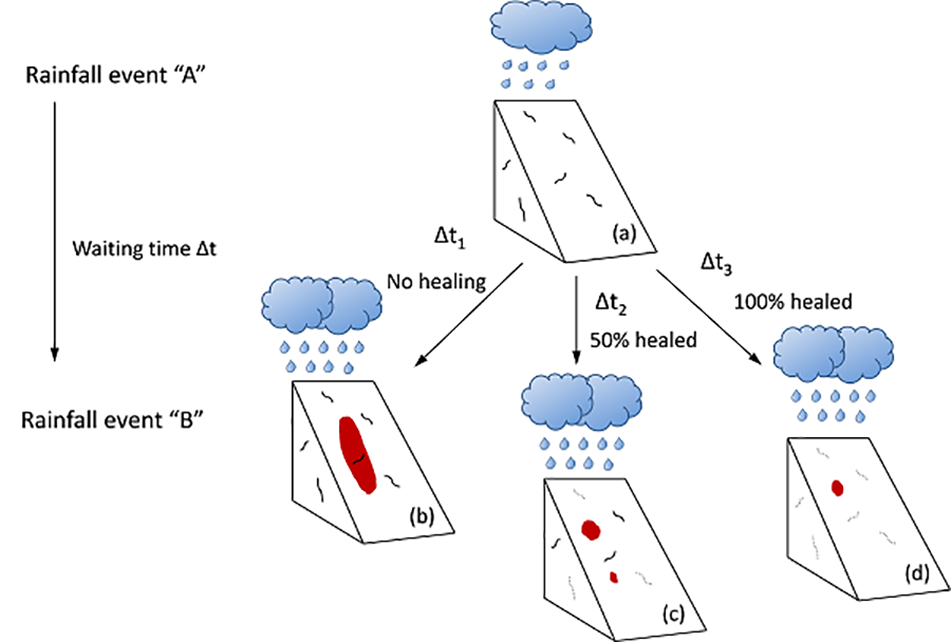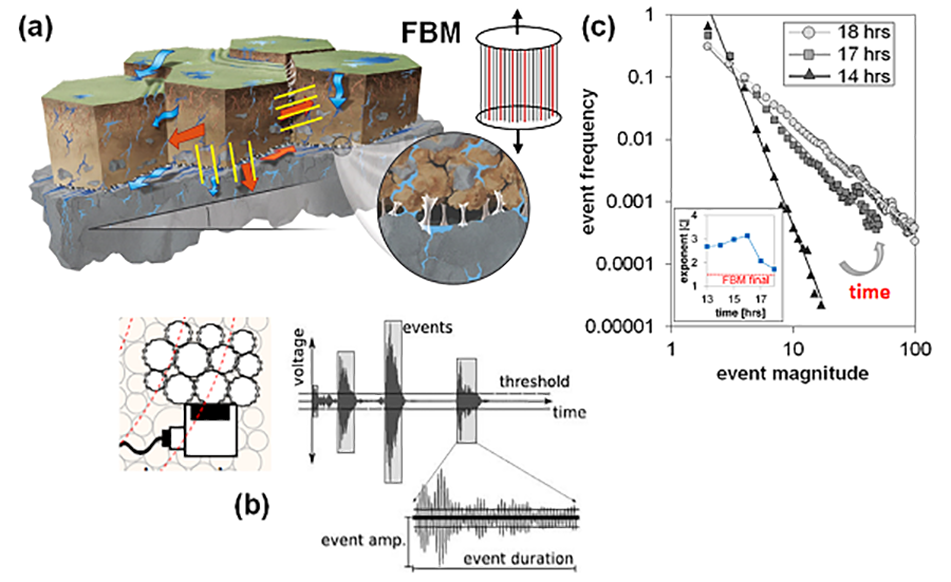Hydro-mechanical Loading History and Shallow Landslide Triggering
The triggering of rainfall-induced shallow landslides is preceded by accumulation of local internal failures in the soil mantle before their abrupt coalescence into a landslide failure plane. The mechanical status of a hillslope reflects the competition between local damage accumulation (e.g., force chains and frictional sliding between grains, microcracks, rupture of capillary bridges and plant roots) and rates of mechanical healing (e.g., re-bonding of microcracks and root regrowth). These internal damages and subsequent mechanical healing may occur during any rainfall event thereby gradually affecting the mechanical status of a hillslope and introducing uncertainty with respect to initial mechanical state of a hillslope for modeling its response to future rainfall events. We evaluated the roles of these dynamic processes on landslide characteristics and patterns using a hydro-mechanical landslide triggering model for a sequence of rainfall scenarios. The damage within a hillslope is modeled as broken fibers representing various mechanical elements such as force chains, friction, capillarity and roots. Healing of soil matrix and roots are formulated in analogy to soil thixotropy and strength regain by growing and maturing roots at respective time scales. This work proposed a quantitative framework for systematically incorporating hydromechanical loading history and information on precursor events (e.g., such as recorded by acoustic emissions) into shallow landslide hazard assessment.

Figure 1: Conceptual sketch illustrating effects of antecedent damage and mechanical healing on future landslide triggering. (a) A rainfall (rainfall event “A”) causes local damage (indicated by black lines) within the hillslope. (b) to (d) Depending on time interval ∆t to the next rainfall (rainfall event “B”), the local damage caused by rainfall event “A” (termed antecedent damage) may heal and regain strength. The interplay between antecedent damage and mechanical healing changes the initial mechanical state of the hillslope at the onset of rainfall event “B”, resulting in different locations and magnitudes of mass release that is triggered by rainfall event “B” (red shapes).
The significance of hillslope initial mechanical state in landslide triggering is neglected by most landslide models due to the technical challenges to measure local damages within a hillslope and the lack of a modeling framework that incorporates the damage information. We identify measuring acoustic emissions associated with local failure events as the only accessible way to quantify hillslope local damage. With the advent of the state-of-the-art fiber-optic based acoustic emission technology, combined with the landslide model we have developed, we aim to develop a framework that will hopefully close the gap between the urgent necessity for hillslope mechanical state quantification and the technical constraints of damage measurement methods. The evolution of recorded AE pattern will be linked to the mechanical state of a hillslope by linking the characteristics of the measured AE signals (e.g., event number, their amplitudes, and statistical features) to fiber breakage quantities (e.g., number and released energy of broken fibers). In a subsequent step, the healing rates of soil matrix and roots which can be determined with lab experiments will be included in the modeling framework. By measuring the AE signatures and representing them in the landslide triggering model, together with the incorporation of possible healing processes, clear patterns of the mechanical state of a hillslope will be mapped.

Figure 2: Concept of linking Acoustic Emission (AE) measurement with landslide modeling to determine the mechanical state of a slope and imminence of mass release. (a) Sketch of the hydro-mechanical landslide triggering model [Fan, et al, 2015]. The soil mantle is discretized into soil columns interconnected by lateral mechanical “bonds” represented by the Fiber Bundle Model. Before mass is released, fibers in the mechanical “bonds” will fail and this damage will be linked to AE signature. (b) The measured AE signal is translated into a series of acoustic ‘events’ representing local damage and interpreted as breaking fibers in the model. (c) The statistics of these ‘events’ (AE-events and breaking fibers) change towards mass release (here shown for a modeled hillslope with mass release after 18 hours of rainfall).
Related publication(s):
Fan, et al, (2015), Effects of Hydromechanical Loading History and Antecedent Soil Mechanical Damage on Shallow Landslide Triggering, Journal of Geophysical Research: Earth Surface, in press.
Team: Dani Or, Peter Lehmann, Linfeng Fan
Funding: Competence Center Environment and Sustainability (CCES)
Students: Linfeng Fan
Contact: